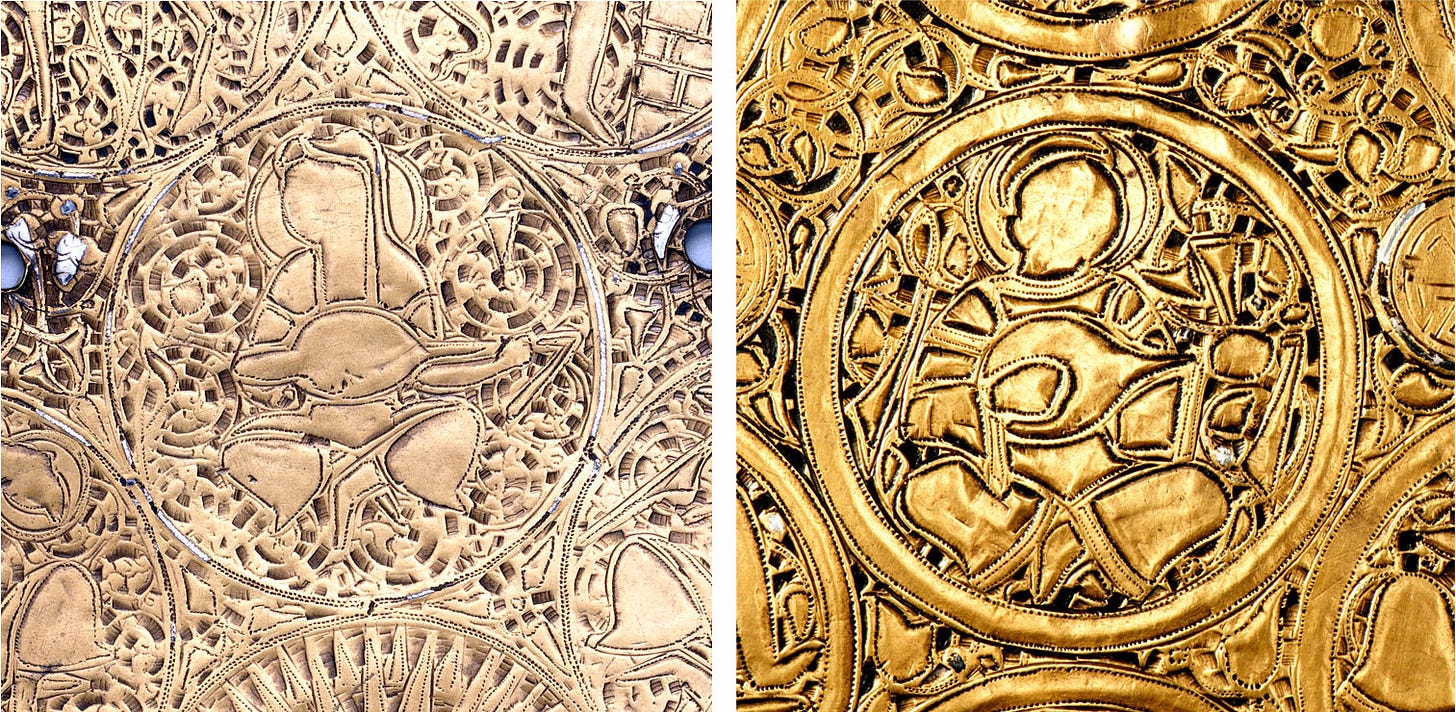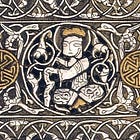The name al-Zuhara comes from the verb zahara “to shine, be radiant” (whence also a word for “flower”), a reference to the planet’s brightness which is second only to the moon’s in the night sky. It’s a pre-Islamic name, originally an epithet of the Meccan goddess al-’Uzza (“the Mighty”, no wilting violet but a war goddess) who was the ruling deity of Venus as Evening Star1.
Picturing Venus (al-Zuhara الزهرة)
Venus has always been regarded as having a positive influence (the “smaller beneficence”, Jupiter being the greater) and a feminine nature, and was represented in Islamic lands as a musician. Her default instrument is the ‘oud (ancestor of the lute) but artists often introduce other instruments when she occurs more than once on one object.2
As planetary Lord of both Taurus and Libra, the figure of Venus is often seen playing while riding a bull or sitting under a set of scales, as we will see below.
For descriptions of the source objects, please refer to the first post in this series.



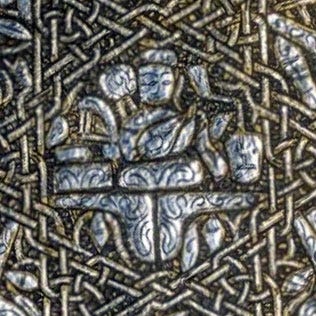
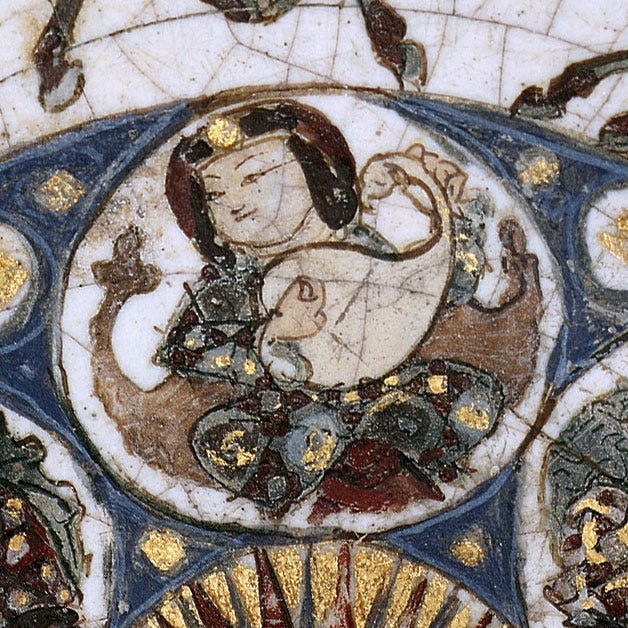

The ewers don’t feature the standalone planets, but we have their representation of Zuhara through the figures for Taurus and Libra:









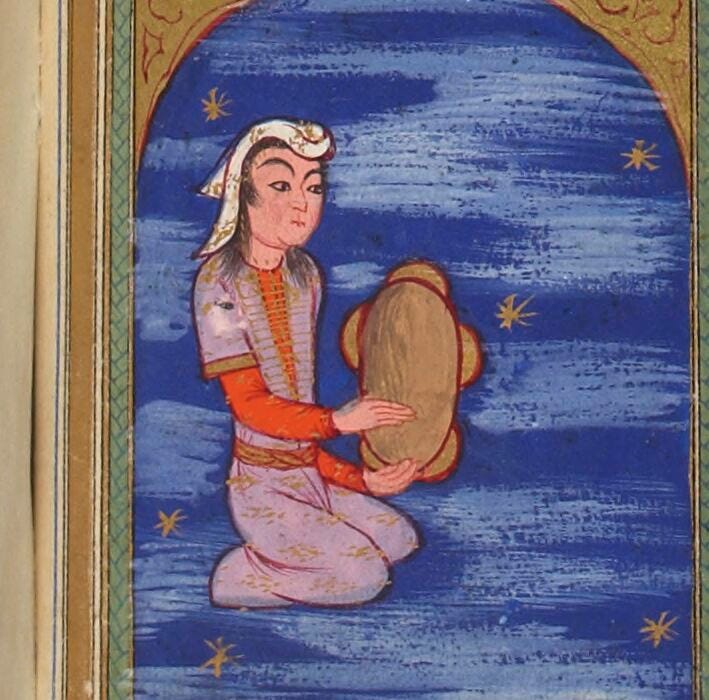


Sigil رسم
The modern symbol for Venus ♀︎ has not changed since late Greek papyri, except for the addition of the crossbar (probably to christianise it). Its origin may be deduced from a Roman planisphere made in the second century AD3 : it shows the gods associated with the planets, each holding as an attribute an object in which we can easily see the root of the abstract symbol in which they have evolved (caduceus for Mercury, a scythe for Saturn and so on). Below is a close-up of Venus:

Different interpretations of the Venus symbol can be attributed to different readings of this image: while the most common reading is that Venus is holding a mirror, this article claims that she has “a necklace which is attached by a cord to another necklace just beyond her shoulder”, and that the necklace, which descends from Ishtar’s “necklace of Fate”, has been mistaken for a mirror. I may be missing some information but I just don’t see how a cord linking two necklaces makes any sense and I certainly can’t see it represented in this image. Either way though, the original symbol is clear: a circle from which a vertical line drops4.
Not that this is especially relevant to us, as the symbols I’ve come across bear no discernible resemblance to it.
Astrolabe 1 once more presents us with a glyph that appears to be derived from the letters in the word زه ر ه . This is again only a guess, but the fact several of the planets appear to display this treatment gives some weight to it. Ghāyat al-Hakīm on the other hand gives us this:
We can discount the little circles as being akin to flourishes, but the basic symbol remains unexplained. I really have no idea where it might come from. The Ghaya is not a particularly consistent body of work, and it takes some of its glyphs directly from Greek sources, but others not at all.
To finish, here are some of the correspondences for Venus listed in it:
Languages: Arabic العربية
Cloth: Washī الوشي (a fabric of many colours, either brocaded or embroidered or painted)
Taste: Everything sweet and creamy كل طيّب الطعم حلو المذاق دسم
Places: Places of pleasures, orchards, sports; places of relaxation and comfort; places of amusements and beautiful women and drinking companions.
Gemstones: Small pearls اللؤلؤ, large pearls الدرّ
Minerals/metals: Lapis lazuli اللازورد, chrysocolla التنكار, litharge المرتك and anything suitable for making women’s ornaments
Plants: Aromatic plants الرياحين, henna الحنّاء, saffron الزعفران, rose الورد, flowers الازهار and blossoms النواوير; all that is pleasant of taste, fine of scent and good-looking
Pharmaceutics: Balm-tree البلسان, moringa seed حبّ البان, mahaleb cherry stone حبّ المحلب, and everything with a fine smell; of perfumes musc المسك and amber العنبر
Animals: Camels الابل; those that are beautiful in appearance and balanced in figure such as antelopes الظبي, gazelles الغزلان, lambs الضأن, rabbits الارانب; every beautiful bird lovely of sound and sight, that warbles marvelously such as partridges الحجل, doves اليمام, songbirds العصافير, chickens الدجاج, and such; every insect in which there is colour and beauty.
Colours: Bright, and gold tending to green الزرقة والذهبية المائلة إلى الخضرة
Next stop: the Sun!
Previous posts in this series:
Due to its proximity to the sun, what we now understand to be the planet Venus periodically appears to vanish in one place and reappear in another place. Because of this, some cultures mistook it for two separate astral bodies: the Morning Star and the Evening Star. This was true of Arabian tribes but also of early Canaanites, who used different imagery for the two until at some point down the line they realised they were the same, and the imagery merged. In al-’Uzza’s time, the Morning Star was considered to be the incarnation of a male deity called Athtar.
I am no expert in musical instruments, and my identification of them is only tentative. It would be fascinating to have an expert examine and perhaps identity the instruments played by al-Zuhara in different times and places.
Bianchini’s planisphere, now in the Louvre.
For what I think of the new agey claims that it’s made up of the circle of the sun above the cross of earth symbolising the triumph of spirit over matter, see part 2, footnote 6.




